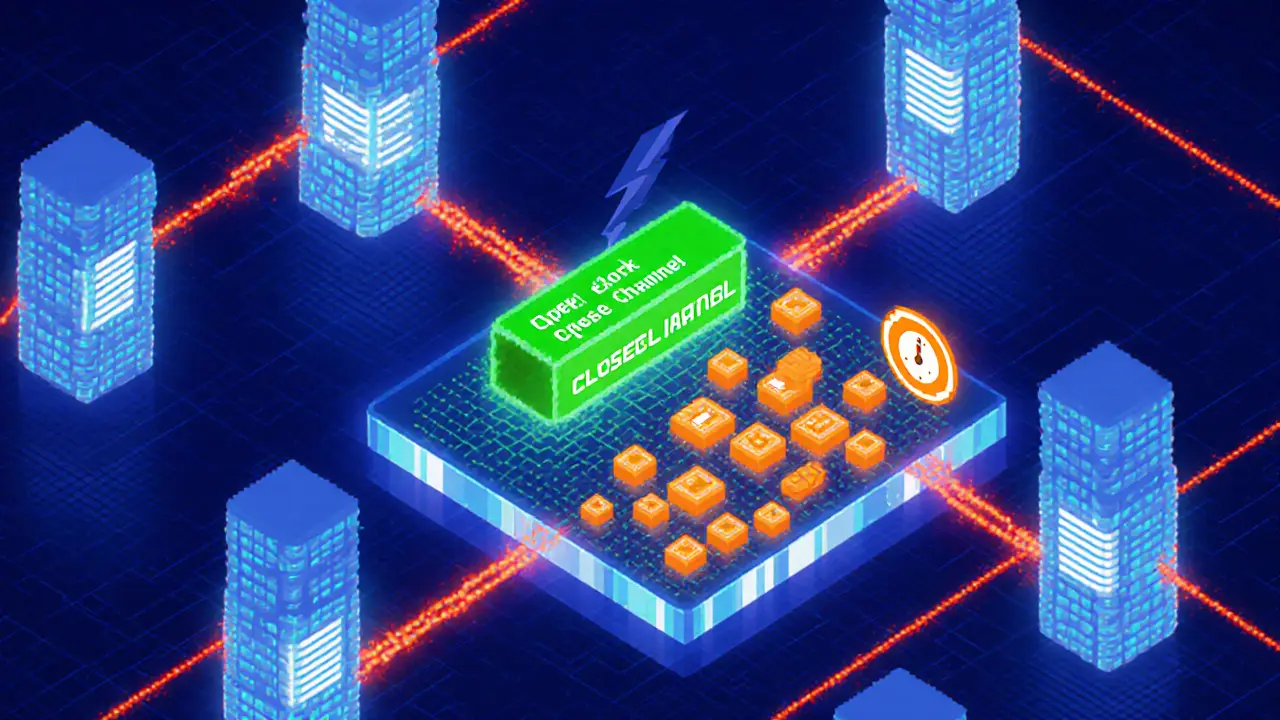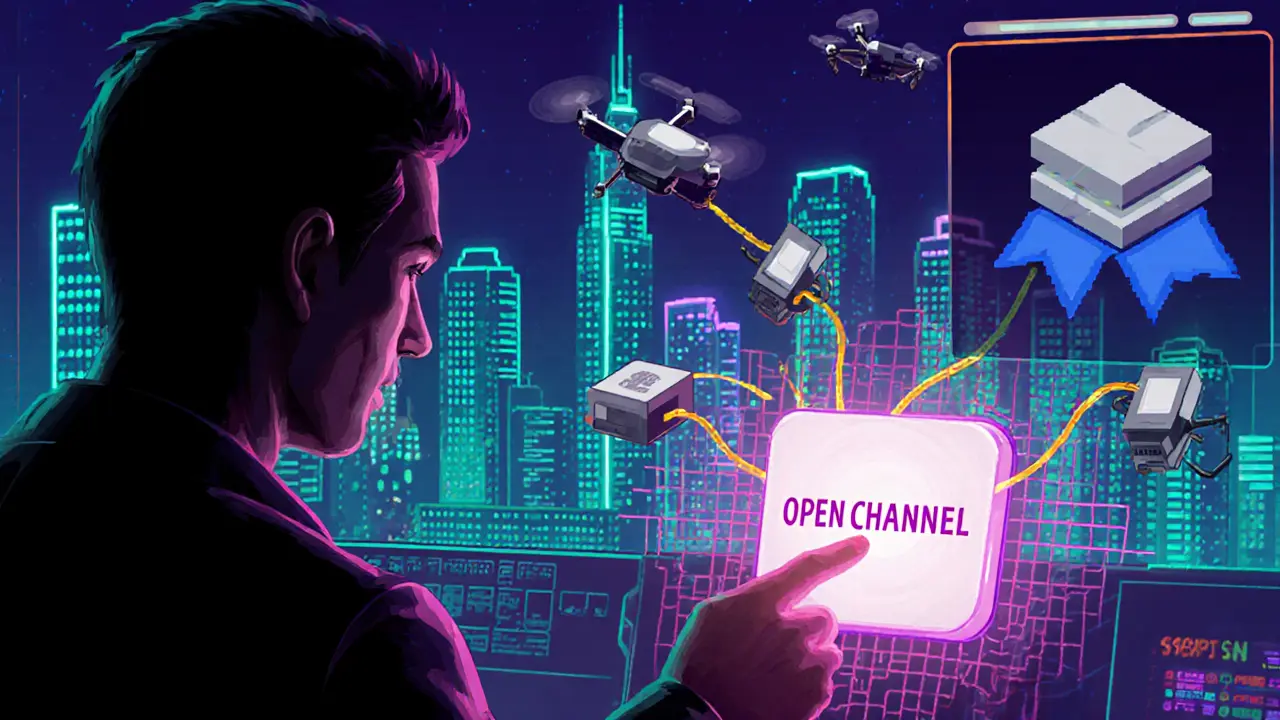Posted By Tristan Valehart On 27 Jan 2025 Comments (23)

State Channels Comparison Tool
Recommended Solution
Detailed Comparison
| Aspect | State Channels | Rollups | Sidechains |
|---|---|---|---|
| On-chain Writes | 2 (open + close) | Periodically batched | Continuous but separate chain |
| Latency | Sub-second (off-chain) | Seconds-to-minutes (challenge period) | Similar to main chain |
| Best Use Case | Micropayments, gaming, IoT between known peers | General dApps needing rollup security | Asset transfer with custom rules |
| Capital Lock-up | Required for the channel’s lifetime | Only for batch settlement | Varies by sidechain design |
| Routing Complexity | Multi-hop routing still evolving | Native to rollup architecture | Depends on bridge design |
Imagine you could zip a hundred payments between two friends without ever touching the main blockchain until you’re done. That’s the promise of State Channels is a Layer2 scaling technique that moves transaction processing off‑chain while keeping the security guarantees of the underlying blockchain. By locking a small amount of crypto in a smart contract and letting participants trade back and forth privately, they can settle just one final state on the chain. The result? Near‑instant transfers, tiny fees, and a way to scale blockchain usage without overloading the network.
TL;DR
- State channels lock assets in a multisig contract, enabling unlimited off‑chain swaps.
- Only the opening and closing transactions hit the main chain, slashing fees dramatically.
- Lightning Network (Bitcoin) and Raiden Network (Ethereum) are the flagship implementations.
- Best for micropayments, gaming, and any high‑frequency interaction between known parties.
- Challenges include capital lock‑up, need for online presence, and routing complexity.
What Exactly Are State Channels?
A Layer 2 solution that operates on top of the base blockchain to improve throughput and reduce costs by moving most activity off‑chain. In a state channel, participants create a private ledger that records every movement of value. The ledger’s current "state" is signed by every party, so anyone can prove who owns what at any point.
The magic lies in two simple ideas:
- Lock a portion of the blockchain’s state in a Multisignature Contract that requires signatures from all channel members before funds can be moved.
- Exchange signed updates off‑chain, each one superseding the previous version.
When the channel closes, the latest signed state is submitted to the blockchain, and the contract releases the funds accordingly.
How a State Channel Works - Step by Step
1. Opening the Channel (On‑Chain)
Both parties fund the multisig contract with the assets they intend to trade - Ether, ERC‑20 tokens, even NFTs. This transaction is the only on‑chain write required to start the channel.
2. Exchanging Off‑Chain Updates
Each new payment is a tiny data packet that includes:
- The updated balances for every participant.
- A monotonically increasing nonce (a number that never repeats).
- Signatures from all parties confirming the new state.
Because the packets never hit the chain, they’re essentially free and settle in milliseconds.
3. Closing the Channel (On‑Chain)
When the participants are done, one of them submits the latest signed state to the Dispute Resolution routine a built‑in safety window that lets the other party challenge an outdated closing attempt. If the counterpart replies with a newer state within the challenge period, the contract accepts that version instead.
If no dispute is raised, the contract releases the locked assets according to the submitted balances.
4. Handling Disputes
Should a party try to close with an old state, the other side can submit a more recent, signed version. The contract then enforces the latest state and may penalize the dishonest party by slashing a portion of their deposit. This mechanism preserves the blockchain’s security guarantees even though most activity occurs off‑chain.
Real‑World Implementations
The concept isn’t just theory. Two ecosystems have built mature, production‑ready networks:
- Lightning Network is Bitcoin’s state‑channel fabric, powering over 4,000 nodes and handling billions of satoshis in daily volume.
- Raiden Network brings similar capabilities to Ethereum, enabling fast ERC‑20 transfers.
Both projects prove that state channels can sustain high‑frequency, low‑fee payments at scale.

When to Use State Channels vs. Other Layer2 Solutions
State channels sit alongside sidechains, plasma chains, and rollups. Each has a sweet spot. Below is a quick side‑by‑side comparison.
| Aspect | State Channels | Rollups (Optimistic/Zero‑Knowledge) | Sidechains |
|---|---|---|---|
| On‑chain writes | 2 (open+close) | Periodically batch (e.g., every few minutes) | Continuous but separate chain |
| Latency | Sub‑second (off‑chain) | Seconds‑to‑minutes (challenge period) | Similar to main chain |
| Best use case | Micropayments, gaming, IoT between known peers | General dApps needing rollup security | Asset transfer with custom rules |
| Capital lock‑up | Required for the channel’s lifetime | Only for batch settlement | Varies by sidechain design |
| Routing complexity | Multi‑hop routing still evolving | Native to rollup architecture | Depends on bridge design |
If you need instant, cheap swaps between a fixed set of parties, state channels usually win. For broader public DApps, rollups often make more sense.
Pros and Cons - A Balanced View
- Pros
- Near‑zero fees - you only pay for two on‑chain transactions.
- Instant finality for participants because updates are exchanged directly.
- Strong security: the underlying blockchain can intervene if a dispute arises.
- Scales virtually without limit - the number of off‑chain messages doesn’t affect on‑chain load.
- Cons
- Both sides must stay online to respond to disputes within the challenge window.
- Funds are locked for the channel’s entire lifespan, tying up capital.
- Routing payments through several intermediaries is still a research challenge.
- Implementation complexity is higher than simply using a rollup.
Getting Started - A Mini Guide for Developers
If you’re a developer eyeing state channels, follow these practical steps. The workflow assumes you’re comfortable with Solidity/Ethereum or Bitcoin scripting, but the principles apply across chains.
- Choose a framework - Lightning Labs (for Bitcoin) or Raiden (for Ethereum) provide reference implementations.
- Set up a local testnet. Deploy a Multisignature Contract that holds the assets you’ll trade.
- Write the off‑chain messaging layer: use libp2p, gRPC, or simple HTTP endpoints to exchange signed state updates.
- Implement the dispute‑resolution logic - include a timeout window (e.g., 24hours) and a function that validates newer states against older ones.
- Test end‑to‑end: Open the channel, perform dozens of off‑chain payments, then close it. Verify that the on‑chain settlement matches the expected final balances.
- Audit the contract. Even though most work happens off‑chain, a bug in the escrow contract can lock funds forever.
Expect a learning curve of 2-4 weeks if you already know smart contracts; newcomers may need a couple of months.
Common Pitfalls & Pro Tips
- Pitfall: Forgetting to monitor the dispute window.
- Pro tip: Build an automated watcher that alerts you (or auto‑submits) if a counter‑party tries to close with an outdated state.
- Pitfall: Over‑locking capital and ending up with idle funds.
- Pro tip: Size channels based on expected traffic; you can close and reopen with minimal overhead.
- Pitfall: Assuming routing works out‑of‑the‑box.
- Pro tip: Use existing routing protocols like Lightning’s source‑specific multi‑path payments, or design a hub‑spoke architecture for simple use cases.
Future Outlook - Where Are State Channels Heading?
Industry analysts agree that state channels will stay vital for niche, high‑frequency scenarios. Recent upgrades to the Lightning Network focus on smoother channel management and better multi‑hop routing, while Raiden’s roadmap is shifting toward hybrid solutions that combine rollups with channel‑style micro‑transactions.
Expect three trends over the next few years:
- Improved UI/UX: Wallets will embed one‑click channel opening, relieving users from manual fund locking.
- Hybrid Layer2 stacks: Projects will nest state channels inside rollups to get the best of both worlds - batch settlement plus instant micro‑payments.
- Enterprise pilots: IoT and pay‑per‑use SaaS models are testing channels for real‑time meter‑based billing.
While rollups may dominate generic scaling, state channels will keep the lightning‑fast edge for the right problems.

Frequently Asked Questions
What is the difference between a state channel and a sidechain?
A state channel keeps all activity off‑chain and only settles the final state on the main chain, requiring just two on‑chain transactions. A sidechain is a separate blockchain that runs its own consensus; assets move between the main chain and sidechain via bridges, so both chains record activity.
Do I need to stay online for the entire channel lifetime?
You don’t have to be online for regular off‑chain payments, but you must be reachable during the dispute window if the other party tries to close the channel with an outdated state. Many implementations provide watchdog bots to handle this automatically.
Can I use state channels with NFTs?
Yes. The locked deposit can include any ERC‑721 token or other NFT standard, allowing parties to exchange ownership off‑chain and settle the final ownership on‑chain.
What happens if both parties cheat during a dispute?
The smart contract verifies the signatures on the most recent state. Any party that submits an older state can be penalized (slashed) according to the contract’s rules, effectively deterring fraud.
Is there a limit to how many participants a channel can have?
Technically you can have many participants, but each added signer raises the complexity of off‑chain coordination and the size of the multisig contract. Most deployments stick to two or three parties for simplicity.


Janelle Hansford
January 27, 2025 AT 03:40Great overview! State channels really shine when you want instant, cheap swaps between friends or game players.
The two‑tx model keeps the main chain happy while you get near‑zero fees.
If you're just starting, try the Lightning Network sandbox to see how opening and closing works.
Remember to keep a small amount of collateral so you don’t lock too much capital.
Krystine Kruchten
January 31, 2025 AT 15:40I appreciate the thorough breakdown; it captures both the elegance and the challenges of off‑chain settlement.
One subtle point is that the dispute window essentially mirrors a Mini‑court on‑chain, requiring parties to stay vigilant.
In practice, many developers implement a watchdog bot – think of it as a friendly sentinel – to automatically push newer states if needed.
Misspelling may happen, but the core idea is clear: you lock funds, trade off‑chain, and let the smart contract enforce honesty.
Iva Djukić
February 5, 2025 AT 03:40State channels constitute a cryptographic abstraction that enables a deterministic off‑chain state transition function to be executed among a bounded set of participants.
Each transition is represented by a signed state object containing a monotonically increasing nonce, the aggregated balances, and a Merkle proof of the underlying application logic.
The security model hinges on the fact that any signed state can be submitted to the on‑chain adjudication contract, which will enforce the most recent valid state according to the highest nonce.
Consequently, the channel’s liveness is guaranteed provided that at least one honest participant can respond within the pre‑specified challenge period.
From a gas‑economics perspective, the amortized cost per off‑chain update approaches zero, as the only on‑chain interactions are the opening and closing transactions.
The initial funding transaction establishes a multisignature escrow that encodes the total collateral pool, often expressed in wei or satoshis depending on the underlying ledger.
Subsequent updates modify the internal balance vector without emitting any logs, thereby preserving privacy and scalability.
However, the protocol must incorporate replay protection, which is achieved by embedding the channel identifier and a strictly incrementing sequence number within each signed state.
Moreover, the dispute resolution routine typically includes a slashing clause that penalizes a party for submitting a stale state, disincentivizing fraudulent behavior.
In implementations such as the Lightning Network, the HTLC (Hashed Time‑Locked Contract) mechanism further extends the primitive to support conditional payments across multiple hops.
Analogously, the Raiden Network leverages a similar conditional lock to enable ERC‑20 token transfers with atomicity guarantees.
When scaling to multi‑party channels, the off‑chain messaging layer must handle consensus on the ordering of updates, often resorting to a leader‑based approach or Byzantine fault‑tolerant protocols.
The trade‑off between channel lifetime and capital efficiency is a pivotal design consideration; longer‑lived channels tie up more capital but reduce the frequency of on‑chain closures.
Operational monitoring tools, such as channel watchtowers, play a critical role in automating the response to potential disputes, thereby mitigating the requirement for constant online presence.
Future research directions include composable channel factories that allow dynamic participant sets and integration with rollup settlement layers to combine the benefits of both paradigms.
Overall, state channels represent a mature, low‑latency solution for high‑frequency micro‑transactions, provided that developers judiciously manage liquidity, monitoring, and routing complexity.
carol williams
February 9, 2025 AT 15:40Look, the thing everyone seems to gloss over is the sheer drama of locking up capital for the lifespan of a channel – it’s like renting a hotel room you’ll never use but you can’t get a refund.
People love to hype the sub‑second latency, yet they forget the “challenge period” is essentially a waiting room where you might have to prove you’re not cheating.
And yes, routing is still a mess; you can’t just throw a payment through five hops and expect it to work like a magic trick.
Bottom line: if you’re not prepared to monitor the channel or risk losing funds to a slashing clause, you’re better off sticking with a rollup.
Maggie Ruland
February 14, 2025 AT 03:40Nice breakdown!
Eugene Myazin
February 18, 2025 AT 15:40Love the optimism vibe here – state channels are like the espresso shot of blockchain scaling.
If you want to keep transactions cheap and fast, just open a channel and watch the fees disappear.
It’s also a great way to showcase cross‑cultural collaboration; you can set up a channel between a dev in Nairobi and one in Buenos Aires and they’ll never notice the mainnet lag.
Latoya Jackman
February 23, 2025 AT 03:40The explanation is clear and concise; however, users should be aware of the responsibility to stay online during the dispute window.
Failing to do so could result in loss of locked assets, which is a non‑trivial risk for occasional participants.
Nilesh Parghi
February 27, 2025 AT 15:40From a philosophical standpoint, state channels illustrate an elegant compromise between trustlessness and practicality.
They let us keep the security guarantees of the base chain while avoiding its performance bottlenecks.
In daily life, think of it like a private ledger between friends that only gets posted to a public notary when the friendship ends.
C Brown
March 4, 2025 AT 03:40Oh sure, “instant payments” and “near‑zero fees” – sounds like the usual hype train, doesn’t it?
But let’s be real: locking up capital is a massive downside, and the whole system collapses if anyone decides to go offline during a dispute.
And don’t even get me started on the routing nightmare – you’ll spend more time configuring hops than actually transacting.
Raphael Tomasetti
March 8, 2025 AT 15:40State channels are a low‑latency L2 solution; ideal for micro‑transactions where gas cost dominates.
Jenny Simpson
March 13, 2025 AT 03:40Honestly, the “instant” claim feels overblown – sure, the off‑chain steps are fast, but the closing dance can still be a slog if the dispute window triggers.
It’s a dramatic contrast to the calm of rollups, which batch everything nicely.
Sabrina Qureshi
March 17, 2025 AT 15:40Wow!!! This article really!!! captures the essence of state channels!!! It’s like reading a roadmap to crypto lightning!!!
Rahul Dixit
March 22, 2025 AT 03:40State channels? More like a magician’s trick – you think the money’s gone, but it’s locked somewhere, waiting for the right moment to re‑appear.
And the whole “watchtower” thing? Just another layer of surveillance to keep the little guys in line.
CJ Williams
March 26, 2025 AT 15:40Great guide! 🙌 Remember to test your channel on a testnet first – you don’t want to lose funds because of a missing signature.
Also, keep an eye on the gas cost of the opening transaction; it can be higher than you expect during network congestion. 😊
mukund gakhreja
March 31, 2025 AT 03:40State channels are awesome – just open one, ping your buddy, and you’re set.
Make sure you’ve got a watcher running, otherwise you’ll get burned if they try to close with an old state.
Michael Ross
April 4, 2025 AT 15:40The explanation is balanced; developers should weigh the capital lock‑up against the speed benefits before committing to a channel implementation.
Deepak Chauhan
April 9, 2025 AT 03:40State channels, as a concept, are theoretically sound, yet the practical deployments often suffer from inadequate monitoring infrastructure.
In jurisdictions with strict regulatory oversight, the capital lock‑up could raise compliance concerns.
Aman Wasade
April 13, 2025 AT 15:40Sure, state channels sound cool, but if you’re not ready to keep an eye on the chain, you might as well stick with a rollup.
Ron Hunsberger
April 18, 2025 AT 03:40For newcomers, I recommend starting with a simple two‑party channel and using an existing library like Lightning‑JS.
The SDK handles most of the heavy lifting, from nonce management to dispute resolution.
Lana Idalia
April 22, 2025 AT 15:40Okay, but do we really need another layer of complexity? You already have smart contracts, why add off‑chain mess?
If anything, it just hides the transaction history from auditors.
Henry Mitchell IV
April 27, 2025 AT 03:40Just a heads‑up: always set up a watchtower if you plan to use channels – it saves a lot of headaches later. 🙂
Narender Kumar
May 1, 2025 AT 15:40Behold! The drama of locked capital, the suspense of dispute windows, the tragedy of missed watchtower alerts!
State channels deliver more theatrics than a Broadway show, but only if you love living on the edge.
Darrin Budzak
May 6, 2025 AT 03:40Exactly, the channel model works best when the participants have a trusted relationship and can keep an eye on the chain.
For broader use‑cases, consider hybrid solutions that combine channels with rollup settlement.